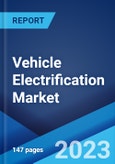Vehicle electrification is the process of using electricity to power a vehicle and replace components that operate on a conventional energy source. It relies on a powertrain driven by electricity and auxiliary systems, such as on-board and off-board charging systems and wireless power transfer, to offer electronic power-assisted steering. It also provides an electronic stability program, electronic traction control, intelligent light system, smart electromagnetic suspension, all-wheel drive, and airbag deployment system. As a result, it finds extensive applications in distribution and field services and long-haul transportation across the globe.
Vehicle Electrification Market Trends:
At present, there is a rise in the demand for electric vehicles (EV) across the globe. This, along with the burgeoning automotive industry, represents one of the key factors driving the market. Moreover, the increasing need for a substitute of conventional hydraulic and mechanical systems. This, coupled with the growing environmental concerns among individuals due to rising carbon dioxide emissions (CO2), is catalyzing the demand for vehicle electrification. In addition, there is a significant focus on weight reduction in automotive components to reduce fuel consumption and enhance the operational efficiency of vehicles. This, in confluence with initiatives undertaken by governments of several countries to promote the use of fuel-efficient vehicles, is propelling the demand for vehicle electrification. Furthermore, declining prices of batteries around the world is offering lucrative growth opportunities to investors and end-users. Additionally, the rising utilization of advanced technologies like e-axle in EVs is positively influencing the market. Furthermore, key market players are extensively investing in research and development (R&D) activities to introduce cost-effective solutions. These players are also focusing on product launches and mergers and acquisitions (M&A), which is projected to increase their overall profitability.Key Market Segmentation:
The publisher provides an analysis of the key trends in each sub-segment of the global vehicle electrification market report, along with forecasts at the global, regional and country level from 2023-2028. The report has categorized the market based on product type, vehicle type and sales channel.Breakup by Product Type:
- Starter Motor
- Alternator
- Electric Car Motors
- Electric Water Pump
- Electric Oil Pump
- Electric Vacuum Pump
- Electric Fuel Pump
- Electric Power Steering
- Actuators
- Start/Stop System
Breakup by Vehicle Type:
- Internal Combustion Engine (ICE) and Micro-Hybrid Vehicle
- Plug-in Hybrid Electric Vehicle (PHEV) and Battery Electric Vehicle (BEV)
- Hybrid Electric Vehicle (HEV)
Breakup by Sales Channel:
- Original Equipment Manufacturers (OEM)
- Aftermarket
Breakup by Region:
- North America
- United States
- Canada
- Asia-Pacific
- China
- Japan
- India
- South Korea
- Australia
- Indonesia
- Others
- Europe
- Germany
- France
- United Kingdom
- Italy
- Spain
- Russia
- Others
- Latin America
- Brazil
- Mexico
- Others
- Middle East and Africa
Competitive Landscape:
The competitive landscape of the industry has also been examined along with the profiles of the key players being Aisin Corporation, BorgWarner Inc., Continental AG, DENSO Corporation, Ford Motor Company, Hitachi Ltd., Johnson Electric Holdings Limited, Magna International Inc., Mitsubishi Electric Corporation, Robert Bosch GmbH, Valeo and ZF Friedrichshafen AG.Key Questions Answered in This Report:
- How has the global vehicle electrification market performed so far and how will it perform in the coming years?
- What has been the impact of COVID-19 on the global vehicle electrification market?
- What are the key regional markets?
- What is the breakup of the market based on the product type?
- What is the breakup of the market based on the vehicle type?
- What is the breakup of the market based on the sales channel?
- What are the various stages in the value chain of the industry?
- What are the key driving factors and challenges in the industry?
- What is the structure of the global vehicle electrification market and who are the key players?
- What is the degree of competition in the industry?
Table of Contents
Companies Mentioned
- Aisin Corporation
- BorgWarner Inc.
- Continental AG
- DENSO Corporation
- Ford Motor Company
- Hitachi Ltd.
- Johnson Electric Holdings Limited
- Magna International Inc.
- Mitsubishi Electric Corporation
- Robert Bosch GmbH
- Valeo
- ZF Friedrichshafen AG.
Methodology

LOADING...
Table Information
| Report Attribute | Details |
|---|---|
| No. of Pages | 147 |
| Published | September 2023 |
| Forecast Period | 2022 - 2028 |
| Estimated Market Value ( USD | $ 85.2 Billion |
| Forecasted Market Value ( USD | $ 131.9 Billion |
| Compound Annual Growth Rate | 7.6% |
| Regions Covered | Global |
| No. of Companies Mentioned | 12 |









